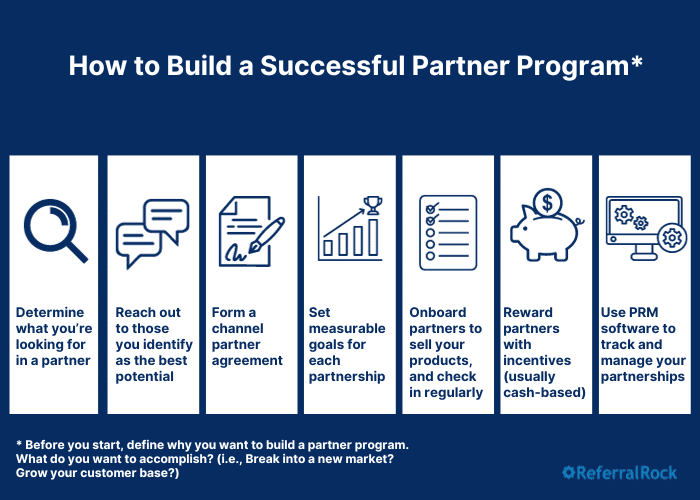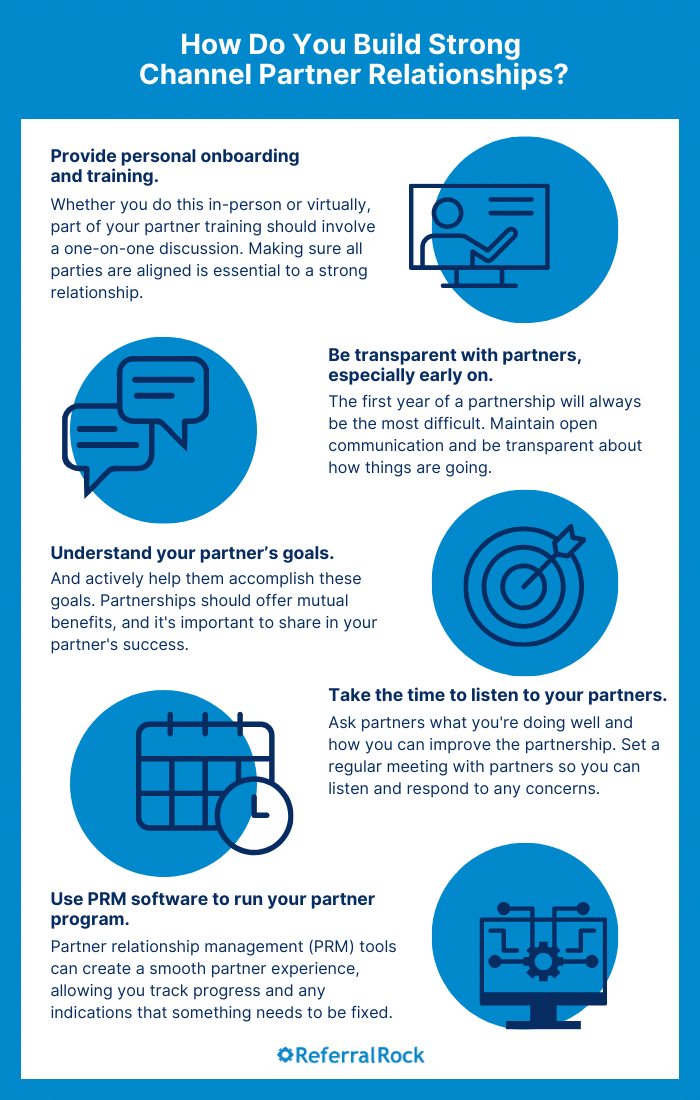Channel partners can help your business widen your reach and achieve goals you wouldn’t be able to accomplish on your own, maximizing your profit in the process.
Find out how to build a channel partner program that’s set up for success with this in-depth channel partner program guide.
What is a channel partner program?
A channel partner program is an initiative where your business enters into an agreement with a third party (usually a service provider) to drive revenue. This type of program widens the distribution of your products or services to new audiences and geographic areas through the third party’s efforts, instead of through direct sales and marketing.
As a reward for distributing your products or services, your business will usually compensate partners with a sales commission or other incentive, which increases in value as they sell more products.
Who could be your channel partners?
Any third party who formally agrees to distribute your products or services to new audiences, and who doesn’t become a direct employee of your company, counts as a channel partner. This third party could be another business or an individual.
Channel partners include businesses that purchase multiple quantities of your products to sell in their own marketplaces. These include retailers, service providers, distributors, wholesalers, and resellers.
Channel partners can also be individual agents or brokers, who help establish partnerships between your business and the businesses they represent.
Surprisingly, even affiliates are sometimes classified as channel partners because they increase your distribution using their own channels. Affiliates place links to your website on their blog or social media accounts. These affiliate links position your company to be discovered by new audiences and widens your geographic reach.
The unique system of all the channel partners that you recruit for your business, with each of their distinct distribution channels, is known as a channel partner ecosystem.
Channel partner program benefits
A successful channel partner program can be an effective way to increase brand awareness in new markets, grow your customer base, and ultimately increase your revenue.
Your partners can help you break into prime markets and verticals that previously haven’t heard of you, and might be difficult for you to reach on your own. As a result, you’re likely to boost lead generation, gain new customers and experience rapid sales growth.
One B2B business, Ringadoc, reported an annual revenue increase of 1,983% and a user base growth of over 1,000%, all thanks to their successful B2B channel partner program. Even more astounding, they achieved this growth within six months, with no upfront costs.
Even if you don’t experience growth that drastic, a partner program can still help you increase your revenue and customer base.
Plus, with a channel partner, you have the backing of a trusted third-party to endorse your product or service. People often trust third-party opinions about your brand far more than they trust messages directly from your company, even if they know that third party is your direct partner.
Is a channel partner program right for you?
Channel partner programs can work well for both B2B and B2C businesses, across nearly every industry, including ecommerce platforms and SaaS. Even with the benefits we’ve listed above, however, channel partner programs aren’t the best fit for every business model.
For the best results, your business should meet these criteria before starting a channel partner program:
- Your business is already established: The quality of your products or services should already be tried, tested, and proven by direct sales. You should have a reasonable demand for your products or services before you attempt to expand distribution.
- Your sales cycles are solidified: Channel partners distribute and sell your products for you. To be most successful with channel partners, you’ll need to know what works best for your in-house sales process before teaching third parties how to sell your products.
- You’ve identified the key markets to reach with partners: Is there a prime market or new vertical you’d like to reach? Would a partner put you in a position to reach that market better than you could on your own? If so, your business is a great fit for a channel partnership.
- You have the bandwidth to accommodate more growth: A channel partnership could potentially bring in a wealth of new customers. You need to make sure your brand can keep up with that growth. For example, do you have enough customer support personnel to respond to the needs of these new customers, while still keeping established customers happy? Will you still be able to maintain the product quality you’re known for, even after the demand for your product has increased?
How to build a channel partner program: The 7 essential steps
Once you’ve decided to build a channel partner program, following these steps will help you set it up for success.
Step 1: Find the right partners
Before starting a partner program, you need to know what you want in a partner and how they would benefit you. This helps you select and recruit the right partners.
Even though partners aren’t your employees, they still represent your brand on a similar level. When it comes to channel partner recruitment, prioritize quality over quantity.
Answer the following questions to help you select the right partners:
What markets or verticals do you want to break into? Select partners who have the best access to these markets, and who are already trusted by these audiences of potential customers.
What goals do you have for your channel partner program? Be specific about these KPIs. For example, by what percentage do you want to grow your customer base? By what percentage do you want to increase company revenue?
How extensively do you want to distribute? Do you want to recruit multiple partners across a variety of geographical markets or verticals?
What types of channel partners will be best for your distribution needs?
- Do you want to partner directly with retailers, who will sell your products in their physical or online storefronts?
- Do you want value-added resellers (VARs) to get your product in end customers’ hands, while adding enhancements and/or providing expertise in how to use it?
- Do you want wholesalers to purchase large quantities of your product all at once?
- Do you want distributors to purchase smaller quantities of your product, and get your product in the hands of retailers?
- Do you want agents or brokers to set up relationships between your company and other companies?
- Do you want affiliates to advertise your products to their online audience for a targeted, yet wide, geographical reach?
- Do you want referral partners from non-competing businesses to send you leads?
Often, you might not be able to get your product directly into larger retailers’ hands. That’s why partnering with a distributor can be so helpful.
What amount of reach do you want each partner to have? For example, do you want local, regional, or national partners? Should each partner have a minimum (or maximum) customer base or estimated audience? Do you want to partner with a new startup, or with a company backed by venture capital?
Sometimes, local partners work better than larger partners because:
- Local partners are more trusted and able to encourage faster purchases
- Local partnerships can be more accessible and cost-effective for smaller businesses
These advantages may outweigh the reach that national partners have. Weigh the benefits and drawbacks of local vs. regional/national partnerships carefully before you proceed.
How do you want partners to distribute your product? Select types of partners based on the distribution method that works best for your product or service. For instance, you could:
- Sell your product through a partner’s online storefront (such as an app store or ecommerce site)
- Work with an affiliate to promote and link to your product on their blog or social media account
- Have a partner sell products in person, but passively (such as snacks are sold at a grocery store)
- Have someone associated with your partnership actively sell your product for you (such as a store employee sells washers and dryers, or a car dealer sells Ford trucks)
What unique advantages would a potential partnership initiative bring you? Brand awareness, brand growth, and access to certain audiences are crucial, but think beyond those benefits. For example, will a partner be a trusted expert in installing your product? Will a partner’s own strong sales team help you close deals as well? Will a new partner’s existing offerings complement your own?
Does distributing your product benefit your potential partner and their audience? Remember, a partnership is a two-way street. Make sure your product or service offers something of genuine value to your partner’s audience. It might be helpful if your partner isn’t already distributing a competing product, but this isn’t always a deal-breaker, as long as your product has unique value that sets it apart.
Is a potential partner ready and able to enter into a solid partnership? In other words, do they have the resources to properly invest in the partnership?
What values does your company hold, and do these values align with your potential partner’s values? Select partners whose value propositions are in harmony with yours. Never partner with a brand whose values or image clashes with yours.
What don’t you want in a partner? Knowing your deal-breakers is just as important as knowing what you look for with a potential partner.
Step 2: Actively reach out to potential partners
Just like with referral programs and affiliate programs, every channel partner program requires active promotion to be successful. But since channel partner programs are usually more exclusive (with hand-picked partnerships), your “promotion” will involve actively reaching out to potential partners. Otherwise, your ideal partners won’t know about your channel program!
Once you’ve identified an ideal potential partner, find and discuss any relevant mutual goals. Clearly identify what you and the potential partner offer each other that you can’t accomplish on your own.
Beyond outlining the mutual benefits that a partnership would offer, use your outreach to survey potential partners about challenges, previous partnerships, and the benefits they seek from the partnership. That way, you can build a partner program that creates the most value.
Plus, relationship-building from the outset is the best way to promote your partner program because potential partners can see you’re willing to listen to their concerns.
Take inspiration from the series of questions Hotjar asks potential partners at their partner program launch (as reported to CXL):
Step 3: Form a channel partner agreement
Once you’ve found and contacted your ideal channel partners, you need to write up a channel partner agreement so you both understand the expectations of the partnership.
The channel partner agreement should:
- Outline shared partnership objectives, including the target markets
- Clarify each of your duties within the partnership
- List the resources each of you will commit to the partnership
- Set expectations and terms for how your partner can and can’t promote your product
- Include the strategies and tactics you’ll use to appeal to your target audience
- Detail any incentives offered by each partner
A channel partner agreement will protect your business from any unethical actions you don’t want partners to take. It also lets partners know what you’ll agree to provide them in return for the partnership.
Channel partner agreements hold both of you accountable. Potential partners will need to read, understand, and sign this binding agreement before doing business with your company.
Step 4: Know the metrics you’ll use to track the success of channel partnerships
How will you know if your channel partner program is successful? Setting and tracking clear, measurable goals for each partnership, and informing partners of these goals, is key.
Your exact goals will vary depending on your partnership, but make sure your goals are SMART: specific, measurable, attainable, relevant, and time-bound.
Here are some examples of SMART goals you could set:
- Generate a minimum of X amount of revenue with the partner program in a given month, quarter, or year
- Generate a minimum of X amount of revenue with a given partnership in a given month, quarter, or year
- Generate a minimum of X amount of revenue within a new vertical in a given month, quarter, or year
- Acquire at least X new customers through all partnerships within a given month, quarter, or year
- Acquire at least X new customers through a specific partnership within a given month, quarter, or year
- Acquire at least X new customers in a given geographical region in a given month, quarter, or year
- Grow your customer base by X% through all partnerships in a given month, quarter, or year
- Grow your customer base by X% through a specific partnership in a given month, quarter, or year (could be specific to region or vertical as well)
- Increase (monthly, quarterly, yearly) purchases from a specific audience demographic by X%
- Increase (monthly, quarterly, yearly) purchases from a given channel by X%
Step 5: Make partner onboarding and communication smooth
You’ll also need to nail down your channel partner enablement for your program to run smoothly. Channel partner enablement involves onboarding and training partners, providing them with tools and resources, communicating with and updating them as needed, and supplying them with everything else they need for successful channel sales.
Partner onboarding is crucial because your partners need to know how to properly promote and sell your products or services.
When you first recruit channel partners, train them on brand and partnership fundamentals. This includes standards for how your brand should be represented, and what key product information they should cover during the sales process.
Training should be customized to each partner, and should focus on how they can pitch the product to meet the needs of your shared audience.
Most importantly, don’t leave partners hanging after their onboarding and training process. Rather, make a plan to regularly check in with partners at set times.
And make sure they know how to contact you, in case they have any questions.
Congratulate the channel partners who are most successful, and regularly update promotional resources that help them continue to sell effectively.
A partner portal or partner dashboard can help you update channel partners, supply brand assets and marketing materials, check their progress, and provide partners with everything they need to be a successful representative of your brand. PRM software can help you create an effective portal; more on PRM software below.
You could also update partners using an email newsletter, private social media group, or Slack group.
Step 6: Offer fair and strategic channel partner incentives
Make sure your partners feel like part of your team – not “outsiders” – so they’ll give time to your company rather than a competitor.
Channel partner incentives encourage partners to stay engaged and sell more products for you. In fact, offering incentives can boost partner sales and profits by as much as 40%. Building incentives into your partner program is vital for the greatest success.
Your channel partner incentive could be a set commission (also called a rebate), which is a percentage of every sale the partner makes for you paid back in cash.
You can also incentivize partners with wholesale discounts, a sales performance incentive fund (SPIF), a market development fund (MDF), or a co-op fund.
No matter which you choose, make sure the incentives are scaled so they’re more motivating and proportionate to the number of sales a partner makes.
In addition to these tangible incentives, think about recognizing your best partners in online spotlights, or treating them to dinners, educational sessions, and other partner-only events to make them feel appreciated.
Step 7: Use PRM software to manage channel partners
The tasks and data involved in managing a channel partner program are usually too overwhelming to accomplish manually – especially if you work with many partners.
PRM software makes starting a channel partner program much easier, assisting companies in recruiting, training, tracking, and managing relationships with your partners. It streamlines all of the tasks associated with your partnership, which makes it a must for any successful partner marketing program.
PRM software is different from CRM tools like HubSpot and Salesforce. While a CRM helps manage customer relationships, a PRM records the leads and sales partners bring in, attributes them to the partners responsible, and passes those leads to a CRM. PRM software also lets you communicate with partners, a feature that CRMs don’t have.
Some of the tasks PRM software (also called partner relationship management software or partner software) can assist you with include:
- Discovering partners
- Creating a partner portal
- Onboarding partners
- Communicating with partners
- Sharing resources and branded sales assets with partners
- Tracking and measuring the success of each partnership in real time
- Rewarding your partners in a timely manner
- Safeguarding the integrity of your brand
Our guide to PRM software will help you pick the right partner management platform for your business needs, and break down the benefits of PRM software in more detail.
Start a channel partner program with confidence
To build a channel partner program, start by carefully evaluating what you want to accomplish through partners and the distribution methods you want them to assist you with.
Remember that your partners are usually service providers, and represent you just like your employees do (even though your they aren’t directly employed at your company). Give them the tools to represent your company professionally, and effectively sell to new markets and verticals.
Software is a key ingredient in designing a high-quality channel partner program that runs smoothly and is easy to scale and measure. See how Referral Rock can automate the process (or read a case study!).







